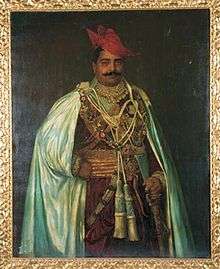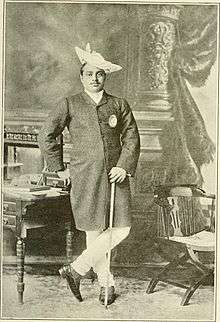Madho Rao Scindia
| Madho Rao Scindia | |
|---|---|
| Maharaja Scindia of Gwalior | |
 "The Maharajah Scindia of Gwalior" | |
| Reign | 20 June 1886 — 5 June 1925 |
| Predecessor | Jayajirao Scindia |
| Successor | George Jivaji Rao Scindia |
| Born |
20 October 1876 Jai Vilas Palace, Laskhar |
| Died |
5 June 1925 (aged 48) Paris, France |
| Burial | Père Lachaise Cemetery (cremated) |
| House | Scindia family |
| Father | Jayajirao Scindia |
| Mother | Sakhyabai Raje Sahib Scindia Bahadur |

Maharaja Sir Madho Rao Scindia of Gwalior GCSI GCVO GBE (20 October 1876 – 5 June 1925), was the 5th Maharaja of Gwalior belonging to the Scindian dynasty of the Marathas.
Biography
Madho Rao acceded to the throne in 1886 and ruled to his death in 1925. He was noted by the British Government as a progressive ruler of a princely state. He was twice married, but had only issue by his second marriage in 1913, one son and one daughter, to whom King George V and Queen Mary stood sponsors. He was succeeded by his only son, Maharajdhiraja Maharaja Sir George Jivaji Rao Scindia, 6th Maharaja Scindia of Gwalior. His daughter married, but died without an issue, in 1934.
The Maharaja of Gwalior is also known as the rejected suitor of Gayatri Devi's mother, the glamorous Princess Indira of Baroda (Indira Devi), who broke off her engagement (contracted between her parents and her fiance) by letter. The Maharaja then married Gajararaje from the Rane family of Goa. Later on Gajararaje's sisters were married into the notable Sardar families of Gwalior which included the Angre, Shitole & the Mahadik Families.
The Maharaja received a number of honours and decorations from the United Kingdom and other Indian States. He was appointed Honorary Aide-de-camp to King Edward VII in 1901, in recognition of his support during the Boxer Rebellion in China.[1] In May the following year, he received the honorary degree LL.D. from the University of Cambridge.[2]
An interesting story is that Madho Rao the Maharajah of Gwailor helped to fund the completion of a set of mosaics in the Church of Ascension in Timoleague, County Cork, Ireland. The mosaics are of particular note, begun in 1894 by Mr. Robert Augustus Travers of Timoleague House in memory of family members, continued in 1918 by his son Robert in commemoration of his father and brother who were killed at Gallipoli. The last phase of the mosaics was at the expense of the Maharajah of Gwailor, installed as a memorial to his friend and physician, Lt. Col Crofts IMS from Councamore, (near Timoleague), who had saved the life of his son. The mosaic was completed by Italian workmen in 1925, ten years after the doctor's death. The mosaic, most likely designed by the Church of Ireland architect W.H. Hill, is a blend of the European and the Islamic. The series of stained glass windows include a Warrington over the altar (east window), glass by Lavers, Westlake and also Mayer elsewhere.The architect Jeremy Williams wrote in 'A Companion Guide to Architecture in Ireland 1837-1921' that "this building was a monument to a living friendship enshrined in a hidden masterpiece of the Arts and Crafts Movement in Ireland" and that it "transcended the sectarian divide between Irish Catholic and Protestant, The Indian Muslim and Hindu, personal friendship breaking up distinctions of caste and colour".[3]
Titles

- 1876-1886: Yuvaraja Maharaj Shrimant Madho Rao Scindia Bahadur
- 1886-1895: His Highness Ali Jah, Umdat ul-Umara, Hisam us-Sultanat, Mukhtar ul-Mulk, Azim ul-Iqtidar, Rafi-us-Shan, Wala Shikoh, Muhtasham-i-Dauran, Maharajadhiraj Maharaja Shrimant Madho Rao Scindia Bahadur, Shrinath, Mansur-i-Zaman, Fidvi-i-Hazrat-i-Malika-i-Mua'zzama-i-Rafi-ud-Darja-i-Inglistan, Maharaja Scindia of Gwalior
- 1895-1898: His Highness Ali Jah, Umdat ul-Umara, Hisam us-Sultanat, Mukhtar ul-Mulk, Azim ul-Iqtidar, Rafi-us-Shan, Wala Shikoh, Muhtasham-i-Dauran, Maharajadhiraj Maharaja Shrimant Sir Madho Rao Scindia Bahadur, Shrinath, Mansur-i-Zaman, Fidvi-i-Hazrat-i-Malika-i-Mua'zzama-i-Rafi-ud-Darja-i-Inglistan, Maharaja Scindia of Gwalior, GCSI
- 1898-1900: Colonel His Highness Ali Jah, Umdat ul-Umara, Hisam us-Sultanat, Mukhtar ul-Mulk, Azim ul-Iqtidar, Rafi-us-Shan, Wala Shikoh, Muhtasham-i-Dauran, Maharajadhiraj Maharaja Shrimant Sir Madho Rao Scindia Bahadur, Shrinath, Mansur-i-Zaman, Fidvi-i-Hazrat-i-Malika-i-Mua'zzama-i-Rafi-ud-Darja-i-Inglistan, Maharaja Scindia of Gwalior, GCSI
- 1900-1902: Colonel His Highness Ali Jah, Umdat ul-Umara, Hisam us-Sultanat, Mukhtar ul-Mulk, Azim ul-Iqtidar, Rafi-us-Shan, Wala Shikoh, Muhtasham-i-Dauran, Maharajadhiraj Maharaja Shrimant Sir Madho Rao Scindia Bahadur, Shrinath, Mansur-i-Zaman, Fidvi-i-Hazrat-i-Malika-i-Mua'zzama-i-Rafi-ud-Darja-i-Inglistan, Maharaja Scindia of Gwalior, GCSI
- 1902-1910: Colonel His Highness Ali Jah, Umdat ul-Umara, Hisam us-Sultanat, Mukhtar ul-Mulk, Azim ul-Iqtidar, Rafi-us-Shan, Wala Shikoh, Muhtasham-i-Dauran, Maharajadhiraj Maharaja Shrimant Sir Madho Rao Scindia Bahadur, Shrinath, Mansur-i-Zaman, Fidvi-i-Hazrat-i-Malika-i-Mua'zzama-i-Rafi-ud-Darja-i-Inglistan, Maharaja Scindia of Gwalior, GCSI, GCVO
- 1910-1917: Major-General His Highness Ali Jah, Umdat ul-Umara, Hisam us-Sultanat, Mukhtar ul-Mulk, Azim ul-Iqtidar, Rafi-us-Shan, Wala Shikoh, Muhtasham-i-Dauran, Maharajadhiraj Maharaja Shrimant Sir Madho Rao Scindia Bahadur, Shrinath, Mansur-i-Zaman, Fidvi-i-Hazrat-i-Malika-i-Mua'zzama-i-Rafi-ud-Darja-i-Inglistan, Maharaja Scindia of Gwalior, GCSI, GCVO
- 1917-1918: Major-General His Highness Ali Jah, Umdat ul-Umara, Hisam us-Sultanat, Mukhtar ul-Mulk, Azim ul-Iqtidar, Rafi-us-Shan, Wala Shikoh, Muhtasham-i-Dauran, Maharajadhiraj Maharaja Shrimant Sir Madho Rao Scindia Bahadur, Shrinath, Mansur-i-Zaman, Fidvi-i-Hazrat-i-Malika-i-Mua'zzama-i-Rafi-ud-Darja-i-Inglistan, Maharaja Scindia of Gwalior, GCSI, GCVO, GBE
- 1918-1925: Lieutenant-General His Highness Ali Jah, Umdat ul-Umara, Hisam us-Sultanat, Mukhtar ul-Mulk, Azim ul-Iqtidar, Rafi-us-Shan, Wala Shikoh, Muhtasham-i-Dauran, Maharajadhiraj Maharaja Shrimant Sir Madho Rao Scindia Bahadur, Shrinath, Mansur-i-Zaman, Fidvi-i-Hazrat-i-Malika-i-Mua'zzama-i-Rafi-ud-Darja-i-Inglistan, Maharaja Scindia of Gwalior, GCSI, GCVO, GBE
Honours
(ribbon bar, as it would look today; incomplete)
![]()
![]()
![]()
![]()
![]()
![]()
![]()
![]()
![]()
- Knight Grand Commander of the Order of the Star of India (GCSI)-1895
- Kaisar-i-Hind Medal, 1st Class-1900
- China War Medal (1900)-1901
- Knight Grand Cross of the Royal Victorian Order (GCVO)-1902
- King Edward VII Coronation Medal-1902
- Knight Grand Cross of the Order of Philip the Magnanimous of Hesse -1903
- Delhi Durbar Gold Medal-1903
- King George V Coronation Medal -1911
- Bailiff Grand Cross of the Venerable Order of Saint John (GCStJ)-1911
- Delhi Durbar Gold Medal-1911
- Knight Grand Cross of the Order of the British Empire (GBE)-1917
References
- ↑ The London Gazette: (Supplement) no. 27337. p. 4916. 24 July 1901.
- ↑ "University intelligence". The Times (36779). London. 28 May 1902. p. 12.
- ↑ "Buildings of Ireland - Church of the Ascension Timoleague".
Links
| Madho Rao Scindia Born: 20 October 1876 Died: 5 June 1925 | ||
| Regnal titles | ||
|---|---|---|
| Preceded by Jayajirao Scindia |
Maharaja of Gwalior 1886–1925 |
Succeeded by George Jivaji Rao Scindia |